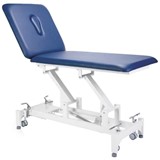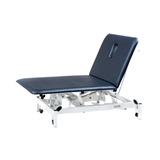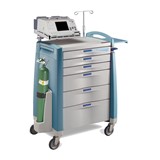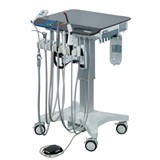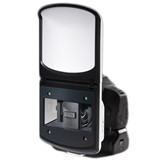I. Introduction
In emergency and critical care settings, time is of the essence. The ability to quickly and accurately diagnose patients can significantly impact their outcomes. Portable ultrasound machines have emerged as invaluable tools for healthcare providers, offering real-time diagnostics on the go. This pillar post delves into the applications of portable ultrasound in emergency medicine and trauma care, highlighting its essential role in improving patient care and optimizing decision-making in critical situations.
II. Applications of Portable Ultrasound in Emergency Medicine and Trauma Care
A. Fast and Accurate Diagnoses at the Point of Care
- Portable ultrasound machines enable healthcare professionals to perform immediate diagnostic imaging at the patient's bedside.
- Real-time imaging allows for rapid visualization of internal structures, aiding in the prompt identification of injuries, abnormalities, or other medical conditions.
- In time-critical situations, such as assessing a patient with acute abdominal pain or suspected internal bleeding, the portability and efficiency of these devices are paramount.
B. Assessing Abdominal Injuries and Internal Bleeding
- Portable ultrasound is particularly valuable in evaluating patients with abdominal trauma.
- By visualizing the abdomen, medical professionals can quickly identify signs of internal bleeding or organ damage, facilitating early intervention and appropriate triage.
- The ability to assess the severity of injuries promptly aids in determining the most suitable course of treatment for the patient.
C. Identifying Pneumothorax and Hemothorax
- Pneumothorax (collapsed lung) and hemothorax (blood accumulation in the pleural cavity) are critical conditions that require immediate attention.
- Portable ultrasound machines allow for the visualization of the pleural space, aiding in the detection of these conditions even in resource-limited environments.
- Rapid identification of pneumothorax or hemothorax guides healthcare providers in making swift decisions regarding chest tube placement or other necessary interventions.
D. Diagnosing Cardiac Emergencies
- Cardiac emergencies demand prompt and accurate diagnoses to guide appropriate management.
- Portable ultrasound devices enable clinicians to perform focused cardiac examinations at the bedside, providing valuable information about cardiac function and identifying potential abnormalities.
- This capability is especially beneficial during cardiac arrest or when dealing with patients with acute chest pain, where every second counts.
III. Ultrasound-Guided Procedures and Interventions in Critical Situations
A. Ultrasound-Guided Vascular Access in Emergency Scenarios:
- Ultrasound aids in locating suitable veins for intravenous access in critical patients.
- Precise visualization helps avoid multiple insertion attempts and reduces patient discomfort.
- Increases success rates, particularly in patients with difficult venous access.
- Useful in emergency situations where time is crucial for patient care.
B. Needle Aspiration and Drainage Procedures:
- Ultrasound guidance enhances the accuracy of needle aspiration and drainage procedures.
- Efficiencies in draining fluid collections, such as abscesses or hematomas, lead to better patient outcomes.
- Reduces the risk of complications by ensuring targeted needle placement.
- Valuable tool in emergency cases, trauma, and infections.
C. Nerve Blocks and Regional Anesthesia Guidance:
- Ultrasound enables real-time visualization of nerves and surrounding structures during nerve blocks.
- Increases the precision of regional anesthesia, minimizing the risk of nerve damage.
- Offers an alternative to traditional methods, particularly when landmarks are challenging to identify.
- Useful for managing pain in critical care and emergency settings.
D. Intraoperative and Postoperative Applications:
- Intraoperative ultrasound assists surgeons in evaluating organs and structures during surgery.
- Helps identify and address potential complications in real-time.
- Postoperative ultrasound aids in assessing surgical outcomes and detecting early complications.
- Provides valuable information for ongoing patient management and care.
IV. Rapid Assessment and Decision-Making with Point-of-Care Ultrasound
A. Streamlining Triage with Portable Ultrasound:
- Portable ultrasound expedites the triage process by providing quick diagnostic information.
- Enables early identification of critical conditions, allowing for prioritization of patients.
- Facilitates timely allocation of resources and appropriate patient care.
- Crucial in mass casualty incidents and crowded emergency departments.
B. Assessing Trauma Patients for Internal Injuries:
- Point-of-care ultrasound aids in rapid assessment of trauma patients for internal bleeding or organ injuries.
- Allows for prompt intervention and surgical planning, if necessary.
- Non-invasive and well-tolerated by patients, making it suitable for unstable or injured individuals.
Reduces the need for more time-consuming imaging techniques.
C. Identifying Life-Threatening Conditions Quickly:
- Portable ultrasound assists in identifying life-threatening conditions like cardiac tamponade or aortic dissection.
- Early detection facilitates immediate life-saving interventions.
- Helps avoid delays in critical situations and ensures timely treatment.
D. Monitoring Treatment Progression in Real-Time:
- Real-time ultrasound monitoring enables healthcare providers to assess treatment effectiveness on the spot.
- Tracks changes in fluid status, organ function, or postoperative recovery.
- Allows for adjustments in treatment plans as needed, leading to personalized patient care.
V. Ultrasound for Bedside Diagnostics and Monitoring in ICU Settings
In the critical environment of an Intensive Care Unit (ICU), where every second counts, integrating portable ultrasound into standard protocols can significantly enhance patient care and outcomes. By providing real-time diagnostic capabilities at the bedside, medical professionals can make timely decisions and tailor treatment plans to individual patient needs. Here are the key aspects of utilizing ultrasound for bedside diagnostics and monitoring in ICU settings:
A. Integrating Ultrasound into ICU Protocols
- Incorporating portable ultrasound as a routine tool in ICU patient evaluations.
- Training ICU staff to effectively and safely use ultrasound for various applications.
- Standardizing ultrasound protocols to ensure consistency and accuracy of findings.
- Collaborating with radiology departments to streamline imaging processes.
B. Evaluating Cardiac Function and Hemodynamics
- Non-invasively assessing cardiac function, including ejection fraction and wall motion.
- Measuring hemodynamic parameters like stroke volume, cardiac output, and central venous pressure.
- Identifying signs of cardiac tamponade, pericardial effusion, and other cardiac abnormalities.
- Monitoring changes in cardiac status during interventions or treatments.
C. Detecting Infections and Complications Early
- Using ultrasound to identify signs of infections, such as pneumonia or urinary tract infections.
- Detecting complications like abscesses or fluid collections that may require drainage.
- Guiding the insertion of catheters or monitoring lines to minimize infection risks.
- Monitoring the progress of infections and assessing treatment effectiveness.
D. Ultrasound for Bedside Hemodynamic Monitoring
- Utilizing ultrasound to assess intravascular volume status and fluid responsiveness.
- Monitoring for signs of hypovolemia, hypervolemia, or fluid overload.
- Guiding fluid resuscitation and optimizing fluid balance in critically ill patients.
- Reducing the need for invasive procedures like central venous catheterization.
VI. Portable Ultrasound in Pre-hospital and Disaster Relief Scenarios
In emergency situations and disaster relief operations, where immediate medical attention can make a life-or-death difference, portable ultrasound becomes an indispensable tool for first responders. Its compact nature and real-time imaging capabilities enable medical personnel to quickly assess patients and allocate resources efficiently. Here's how portable ultrasound proves invaluable in pre-hospital and disaster relief scenarios:
A. Advantages of Using Portable Ultrasound in the Field
- Portability and ease of use, enabling rapid deployment in emergency situations.
- Real-time imaging for on-the-spot diagnostics, aiding triage decisions.
- Reducing the need for patient transportation, particularly in remote or hard-to-reach areas.
- Enhancing communication between first responders and medical facilities for better patient management.
B. Training First Responders for Ultrasound Usage
- Providing comprehensive training to first responders on operating portable ultrasound devices.
- Equipping them with the knowledge to interpret basic ultrasound findings for prompt decision-making.
- Ensuring they adhere to safety protocols while using ultrasound in challenging environments.
- Regularly updating their skills to maintain proficiency.
C. Rapid Triage and Resource Allocation in Disasters
- Conducting quick assessments with portable ultrasound to prioritize patients based on severity.
- Optimizing resource allocation by directing critical cases to appropriate medical facilities.
- Identifying life-threatening conditions, such as internal bleeding or pneumothorax, for immediate intervention.
D. Ultrasound in Remote and Challenging Environments
- Overcoming logistical challenges by using portable ultrasound in remote areas.
- Assisting in disaster scenarios with compromised infrastructure and limited medical resources.
- Providing crucial information to medical teams before a patient reaches a healthcare facility.
- Contributing to successful outcomes in resource-constrained settings.
VII. Training Emergency Responders for Efficient Ultrasound Utilization
A. Importance of Proper Training and Certification:
-
Proper training and certification are crucial for emergency responders to effectively utilize portable ultrasound machines in critical situations.
-
Training ensures that responders understand the equipment, ultrasound principles, and image interpretation, reducing the risk of misdiagnoses and errors.
-
Certification validates the responder's competency and adherence to established standards, instilling confidence in their abilities among the medical team and patients.
B. Simulation-Based Training for Emergency Situations:
- Simulation-based training offers a safe and controlled environment to practice using ultrasound in various emergency scenarios.
- Responders can simulate real-life situations, such as trauma cases or cardiac emergencies, enhancing their skills and decision-making abilities.
- This training approach allows for repeated practice, which is essential for gaining proficiency and confidence in handling portable ultrasound devices.
C. Continuing Education and Skill Maintenance:
- Continuous learning is essential for emergency responders to stay updated with the latest advancements in ultrasound technology and best practices.
- Regular workshops, seminars, and webinars provide opportunities for skill enhancement and knowledge sharing.
- Skill maintenance through ongoing education ensures that responders maintain their proficiency and stay prepared for diverse emergency situations.
D. Standardizing Ultrasound Training for Consistency:
- Establishing standardized training protocols helps maintain consistency in ultrasound usage across different emergency response teams.
- A uniform approach ensures that all responders are equipped with the same level of knowledge and skills, improving overall patient care.
- Standardization also facilitates better collaboration and understanding among responders from different medical backgrounds.
VIII. Collaborative Efforts to Optimize Emergency Ultrasound Protocols
A. Building Multidisciplinary Teams for Ultrasound Use:
- Creating multidisciplinary teams fosters collaboration among various medical specialties, including emergency medicine, radiology, and critical care.
- Each team member brings unique expertise, contributing to more comprehensive and accurate diagnoses in critical situations.
- Collaborative efforts lead to better patient outcomes and improved integration of portable ultrasound into emergency care protocols.
B. Collecting and Analyzing Data for Quality Improvement:
- Regularly collecting and analyzing data on portable ultrasound usage allows for quality improvement initiatives.
- Analyzing outcomes and performance metrics helps identify areas for enhancement and optimization.
- Evidence-based improvements based on data analysis further enhance the effectiveness and efficiency of ultrasound utilization in emergencies.
C. Integrating Ultrasound into Emergency Medical Services (EMS):
- Integrating portable ultrasound machines into EMS vehicles equips paramedics with valuable diagnostic tools in the field.
- EMS responders can perform initial assessments and transmit crucial information to receiving hospitals, expediting the triage process.
- This integration facilitates better pre-hospital decision-making and patient care during transportation to medical facilities.
D. Collaborating with Radiologists and Sonographers:
- Collaboration with radiologists and sonographers enhances the expertise available for complex cases and challenging diagnoses.
- Radiologists can provide remote guidance and support to emergency responders through tele-ultrasound or teleconsultation.
- Joint training sessions foster mutual understanding and efficient communication between emergency responders and imaging specialists.
In conclusion, the integration of portable ultrasound machines into emergency and critical care settings has ushered in a new era of rapid and accurate diagnostics, fundamentally transforming patient care. The pivotal role of portable ultrasound in emergency medicine and trauma care cannot be overstated. These devices empower healthcare providers with real-time imaging capabilities at the point of care, enabling timely and informed decision-making in critical situations.




